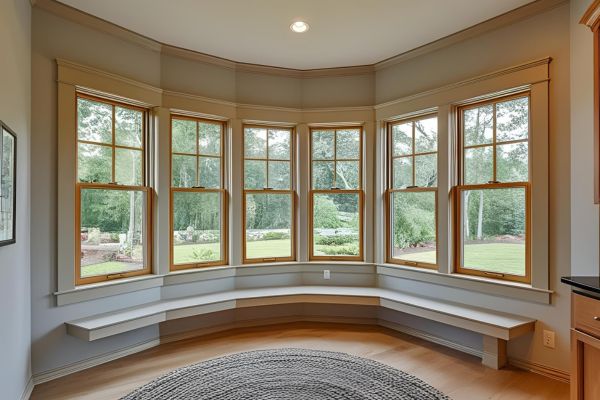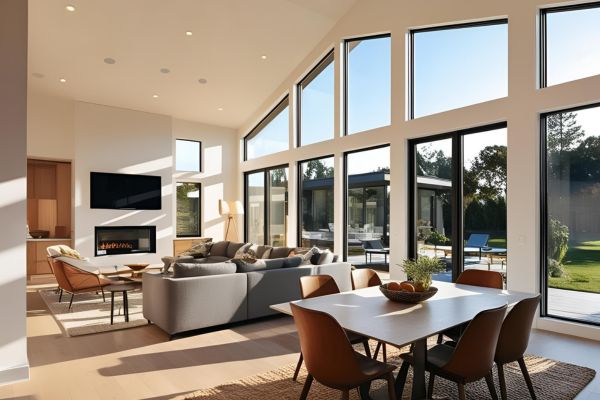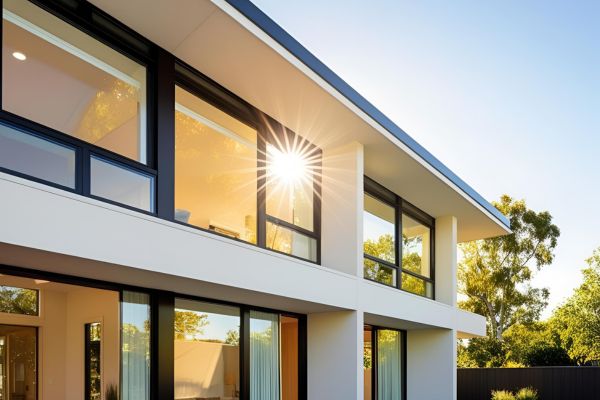High-efficiency windows are rapidly becoming a staple in modern home design, offering a blend of energy savings, comfort, and sustainability. As homeowners seek ways to reduce energy consumption and enhance indoor living conditions, these advanced windows provide a solution that not only cuts down utility bills but also improves overall home efficiency. With advancements in window technology, such as double or triple glazing, low-E coatings, and insulated frames, high-efficiency windows are redefining home insulation and design.

What Are High-Efficiency Windows?
High-efficiency windows are designed to minimize heat transfer, keeping homes cooler in summer and warmer in winter. Unlike traditional windows, they incorporate multiple layers of glass, specialized coatings, and gas-filled spaces between panes to enhance insulation. These features significantly improve thermal efficiency and reduce energy loss.
The Science Behind High-Efficiency Windows
Modern high-efficiency windows use a combination of advanced materials and technology to achieve superior insulation. Low-emissivity (low-E) coatings reflect heat while allowing light to pass through, reducing the need for excessive heating or cooling. Inert gas fills, such as argon or krypton, are placed between panes to minimize heat transfer. Additionally, high-quality frame materials like vinyl, fiberglass, or composite wood provide excellent thermal resistance, further preventing energy loss.
Why High-Efficiency Windows Are Gaining Popularity
With rising energy costs and growing concerns over environmental sustainability, homeowners are increasingly turning to high-efficiency windows. Many governments offer incentives and tax credits for energy-efficient home improvements, making these windows a practical and financially attractive investment. Additionally, advancements in manufacturing have made high-performance windows more accessible and affordable than ever before.

Benefits of High-Efficiency Windows in Modern Home Design
Improved Energy Efficiency
High-efficiency windows help regulate indoor temperatures by reducing heat loss in winter and heat gain in summer. Features like low-E coatings reflect infrared light, keeping warmth inside during colder months and blocking excessive heat in warmer seasons. This leads to significant reductions in the energy needed for heating and cooling.
Lower Utility Bills
By improving insulation and reducing the need for artificial heating and cooling, high-efficiency windows can lower household energy bills by up to 30%. This cost-saving benefit makes them a worthwhile investment, especially in regions with extreme seasonal temperatures.
Enhanced Indoor Comfort
Drafts and temperature fluctuations are common issues with traditional windows, leading to discomfort and uneven heating or cooling. High-efficiency windows eliminate these problems by providing superior insulation, ensuring a consistent indoor climate year-round. This results in a more comfortable living space with fewer temperature-related inconveniences.
Noise Reduction
Living near busy roads, airports, or crowded urban areas can be challenging due to constant noise pollution. High-efficiency windows, with their multi-pane construction and insulated frames, act as a barrier against external noise, creating a quieter and more peaceful indoor environment.

Increased Home Value
Energy-efficient upgrades are highly attractive to prospective homebuyers. Installing high-efficiency windows can increase property value and make homes more appealing in the real estate market. Buyers recognize the long-term savings and improved comfort these windows offer, making them a strong selling point.
UV Protection
Prolonged exposure to UV rays can cause fading and deterioration of furniture, flooring, and artwork inside a home. High-efficiency windows come with UV-blocking coatings that help protect interiors from sun damage while still allowing natural light to enter. This extends the lifespan of household items and reduces maintenance costs.
Environmental Benefits
High-efficiency windows contribute to a reduced carbon footprint by lowering overall energy consumption. With buildings accounting for a significant portion of global energy use, upgrading to energy-efficient windows plays a crucial role in reducing greenhouse gas emissions and promoting sustainability.
Condensation Control
Traditional windows often experience condensation buildup, leading to mold growth and water damage. High-efficiency windows reduce condensation by maintaining a stable indoor temperature and using advanced sealing techniques to prevent moisture accumulation.
Choosing the Right High-Efficiency Windows
When selecting high-efficiency windows, homeowners should consider several factors, including frame material, glazing options, and energy ratings. Frames made from vinyl, fiberglass, or wood composites offer excellent insulation. Double or triple-pane glass with argon or krypton gas fills enhances thermal performance. Additionally, windows with ENERGY STAR certification provide verified energy-saving benefits. Proper installation is equally important, as poorly installed windows can compromise efficiency and lead to energy leaks.
Frame Materials and Their Impact
- Vinyl: Affordable and low-maintenance with good insulation properties
- Fiberglass: Durable and highly energy-efficient but more expensive
- Wood Composite: Offers the aesthetics of wood with the efficiency of modern materials
Glass Types and Coatings
- Double-pane: A standard choice that balances cost and efficiency
- Triple-pane: Provides superior insulation, ideal for colder climates
- Low-E Coating: Reduces infrared heat transfer and UV exposure without sacrificing visibility
Future Trends in High-Efficiency Windows
As technology continues to advance, high-efficiency windows are incorporating smart features to further enhance their performance. Innovations such as electrochromic glass, which tints automatically based on sunlight exposure, and solar-integrated windows that generate electricity, are emerging trends in the industry. These features offer even greater energy savings and contribute to the growing smart home movement.
High-Efficiency Windows are a Game-Changer
High-efficiency windows are a game-changer for modern home design, offering multiple benefits that extend beyond energy savings. From improved comfort and noise reduction to increased home value and environmental impact, these windows are a smart investment for homeowners looking to enhance their living spaces. As technology advances and awareness grows, the adoption of high-efficiency windows will continue to rise, making homes more sustainable and cost-effective in the long run.




